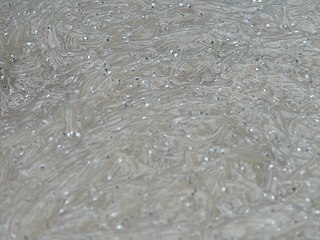
Smelts are a family of small fish, the Osmeridae, found in the North Atlantic and North Pacific Oceans, as well as rivers, streams and lakes in Europe, North America and Northeast Asia. They are also known as freshwater smelts or typical smelts to distinguish them from the related Argentinidae, Bathylagidae, and Retropinnidae.

A wallaby is a small or middle-sized macropod native to Australia and New Guinea, with introduced populations in New Zealand, Hawaii, the United Kingdom and other countries. They belong to the same taxonomic family as kangaroos and sometimes the same genus, but kangaroos are specifically categorised into the four largest species of the family. The term "wallaby" is an informal designation generally used for any macropod that is smaller than a kangaroo or a wallaroo that has not been designated otherwise.

Araucaria is a genus of evergreen coniferous trees in the family Araucariaceae. There are 20 extant species in New Caledonia, Norfolk Island, eastern Australia, New Guinea, Papua (Indonesia), Argentina, Chile, Brazil, and Paraguay.

The Osmeriformes are an order of ray-finned fish that includes the true or freshwater smelts and allies, such as the galaxiids and noodlefishes; they are also collectively called osmeriforms. They belong to the teleost superorder Protacanthopterygii, which also includes pike and salmon, among others. The order's name means "smelt-shaped", from Osmerus + the standard fish order suffix "-formes". It ultimately derives from Ancient Greek osmé + Latin forma, the former in reference to the characteristic aroma of the flesh of Osmerus.

Nothofagus, also known as the southern beeches, is a genus of 43 species of trees and shrubs native to the Southern Hemisphere in southern South America and Australasia. The species are ecological dominants in many temperate forests in these regions. Some species are reportedly naturalised in Germany and Great Britain. The genus has a rich fossil record of leaves, cupules, and pollen, with fossils extending into the late Cretaceous period and occurring in Australia, New Zealand, Antarctica, and South America. In the past, they were included in the family Fagaceae, but genetic tests revealed them to be genetically distinct, and they are now included in their own family, the Nothofagaceae.

The Retropinnidae are a family of bony fishes that contains the Southern Hemisphere smelts and graylings. They are closely related to the northern smelts (Osmeridae), which they greatly resemble, but not to the northern graylings (Thymallus). Species from this family are only found in southeastern Australia and New Zealand. Although a few species are partly marine, most inhabit fresh or brackish water.

The delta smelt is an endangered slender-bodied smelt, about 5 to 7 cm long, in the family Osmeridae. Endemic to the upper Sacramento-San Joaquin Estuary of California, it mainly inhabits the freshwater-saltwater mixing zone of the estuary, except during its spawning season, when it migrates upstream to fresh water following winter "first flush" flow events. It functions as an indicator species for the overall health of the Delta's ecosystem.

The New Zealand smelt, also known as the New Zealand common smelt or New Zealand cucumber fish, is a smelt of the family Retropinnidae, found only in New Zealand at shallow depths in estuaries and rivers. Their length is between 8 and 13 cm.
Cucumberfish is a common name for several fish and may refer to:

The New Zealand grayling, also known as upokororo, pokororo, paneroro, and kanaekura (Māori), is an extinct smelt of the genus Prototroctes, which was found only in lowland rivers and streams of New Zealand. They were an amphidromous species—spawning in freshwater streams and developing to maturity in saltwater. Their length was between 20 and 40 cm.
Paracalliope is a genus of amphipod crustaceans that live in Australasia. They include the most common freshwater amphipods in New Zealand, where they are particularly frequent in slow-flowing reaches of rivers. They shelter among weed beds and are important prey items for fish such as the New Zealand smelt, Retropinna retropinna, which are in turn important prey for the freshwater eels Anguilla australis and Anguilla dieffenbachii. Paracalliope acts as an intermediate host for the nematode Hedruris spinigera, which can thus reach their primary host, the eel.

The Australian smelt is a small, pelagic silvery freshwater fish found in large numbers in waters of the south eastern Australian mainland.

The Tasmanian smelt is a small, pelagic freshwater smelt found in lowland streams of Tasmania, Australia.

The Sillaginidae, commonly known as the smelt-whitings, whitings, sillaginids, sand borers and sand-smelts, are a family of benthic coastal marine fish in the order Perciformes. The smelt-whitings inhabit a wide region covering much of the Indo-Pacific, from the west coast of Africa east to Japan and south to Australia. The family comprises only five genera and 35 species, of which a number are dubious, with the last major revision of the family in 1992 unable to confirm the validity of a number of species. They are elongated, slightly compressed fish, often light brown to silver in colour, with a variety of markings and patterns on their upper bodies. The Sillaginidae are not related to a number of fishes commonly called 'whiting' in the Northern Hemisphere, including the fish originally called whiting, Merlangius merlangus.
Abergasilus amplexus is a species of parasitic copepod endemic to euryhaline habitats in New Zealand. It is the only known species in the genus Abergasilus.

Whitebait is a collective term for the immature fry of fish, typically between 1 and 2 inches long. Such young fish often travel together in schools along the coast, and move into estuaries and sometimes up rivers where they can be easily caught with fine meshed fishing nets. Whitebaiting is the activity of catching whitebait.

Prototroctes is a genus of New Zealand smelts containing one species native to Australia and another, now extinct, species that was native to New Zealand.

Jarijari were an indigenous Australian people whose traditional territory was located in the Mallee region of Victoria.

Lake Rotokawau is a small volcanic lake 4.1 km (2.5 mi) east of Lake Rotorua in the Bay of Plenty region of New Zealand's North Island. The name is also used for lakes in the Kaipara District, Chatham Islands, on Aupouri Peninsula and near Lake Waikare in Waikato. Access is via Lake Rotokawau Road, from SH30 at Tikitere. The lake is owned and managed by Ngāti Rangiteaorere.













